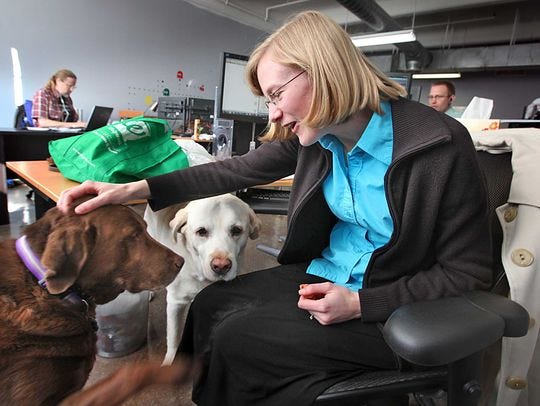Recent study shows pets in the workplace can reduce employee stress… Hmmm, most pet owners knew that years ago without studies!

According to a Virginia Commonwealth University study, employees who bring their dogs to work produced lower levels of the stress-causing hormone cortisol.
Published in spring 2012, the study, led by Randolph Barker, a professor of management, was conducted at a dinnerware company in North Carolina, which sees 20 to 30 dogs a day on its premises. As the workday went on, research found average stress level scores fell about 11% among workers who had brought their dogs to work, while they increased 70% for those who did not.
"When I'm stressed, I usually call Zoe (a chocolate Labrador retriever) over and rub her ear. That's my therapy," said Ann Marie DeLa Rosa, 26, who works at software design company Inverse-Square in downtown Indianapolis and appreciated the company's pet-friendly policy.
Not only does Zoe, who could be mistaken for a small grizzly bear with a smile, alleviate her stress, DeLa Rosa said, the dog also forces her owner to take a lunch break.
"Zoe gets me out," she said. "Otherwise, I tend to power through lunch when I want to get something done. Taking a 15-minute walk with her refreshes me, and I can focus easier."
According to a 2008 national poll of working Americans 18 and older by the American Pet Products Manufacturers Association, 17% reported their company permits pets at work. In 2012, the group reported in a separate study that workers surveyed brought their dogs with them to work 22 times in 2012, compared with 17 times in 2008.
Deb Havill, a clinical social worker and therapist, conducts client sessions along with her two rescue dogs. But David and Jai aren't trained therapy dogs; they just accompany their owner during therapy sessions.
"Dogs were domesticated to be attentive to us," said Havill, who keeps two couches in her Indianapolis office — one for clients and one for the dogs. "It is natural for us to be around them, so to not be around them would be unnatural. We would be in an unnatural state."
Havill explained that touching or petting an animal has been shown to lower the galvanic skin response much like the science behind the polygraph test, when measuring feelings such as fear, stress or anxiety.
"Reaching down and petting a dog is an easy way to ratchet things down when you need to."

Ann Marie DeLa Rosa is shown with her dog, Zoe, a chocolate Labrador retriever as Hoagey, a yellow lab that belongs to fellow worker, noses in for a little TLC. (Photo: Frank Espich, The Indiapolis Star)
Janet Myers travels all over the country with her Bernese mountain dog, advocating the benefits of pet therapy and animal-assisted activities in health care.
A nurse as well as the director of risk management at Schneck Medical Center in Seymour, Ind., Myers founded the hospital's pet-therapy program and next year will speak at the National Pediatric Nurses conference.
Bentley, her dog, is a popular therapy dog with his own children's book and schedule of special appearances. But his main job is still to be with his owner in her office at least three times a week.
"It's been proven that people are always more productive when they are happy," Myers said. "If Bentley is by my side, I am not thinking of needing to be home to care for him or that he's lonely. I often stay late at work with him snoozing away under my desk. He is a big part of my life."
The Centers for Disease Control and Prevention cites dozens of animal experts who report that pets can decrease blood pressure and cholesterol levels as well as increase opportunities for exercise and socialization.
Commercial developer Turner Woodard knows this better than anyone. He's the man who made it possible for employers at The Stutz business center in Indianapolis to have pet-friendly office policies — and about 25% of the tenants take advantage of the perk.
"We know it's a positive," he said. "We need to see more of it in the world."
However, if you're looking to implement a formal policy, there are several factors to consider, Barker said.
"You have to think about employee health (allergies), minimizing disruptions and keeping pets safe," he said.
Amazon and Purina, cited as two of the most pet-friendly companies in the country, don't allow pets because many factories and distribution centers can be dangerous workspaces.
Bob Baird, who brings his two dogs, Ruby and Hoagey to work, knows that when he makes a new hire at Inverse-Square, he might be excluding or discouraging potential applicants who might not like dogs.
"But having dogs here is indicative of our culture," said Baird, whose dog Hoagey, a 110-pound yellow Labrador retriever, is notorious for snoring too loudly during conference calls.
"For us, having dogs in the office is out of necessity," Baird said. "We love having them around because this is (a) home away from home. We work long hours, and it's nice to have them with us."
Related:
Dogs at Work Can Alleviate Employee Stress, Study Shows
Video: Study – Pets in the Work Place Reduce Stress
12 companies that let you bring your dog to work
Chapman University Hosts ‘Furry Friends For Finals’
Londonderry School Uses Therapy Dog in Classroom
Collar to Keep Track of Dogs’ Temperature is in the Works
Pets are way better than Therapy!
Can the U.S. Become a No-Kill Nation?
The Difference Between No Kill Nation & Other Animal Advocacy Groups
Cross-Posted at Just One More Pet
No comments:
Post a Comment